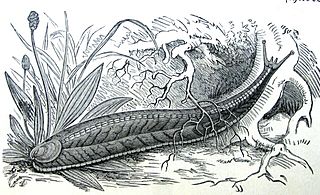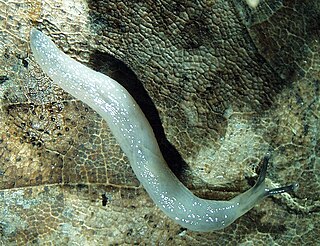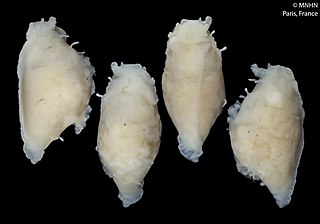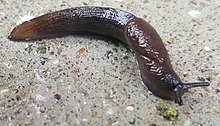
Limax maximus, known by the common names great grey slug and leopard slug, is a species of slug in the family Limacidae, the keeled slugs. It is among the largest keeled slugs, Limax cinereoniger being the largest.

The shelled slug, scientific name Testacella haliotidea, is a rarely seen, air-breathing, carnivorous land slug, a terrestrial gastropod mollusk in the family Testacellidae, the shelled slugs.

The black slug, Arion ater, is a large terrestrial gastropod mollusk in the family Arionidae, the round back slugs. Many land slugs lack external shells, having a vestigial shell. Most slugs retain a remnant of their shell, which is usually internalized, unlike other terrestrial mollusks which have external shells. Without such shells, slugs produce mucus, that may also contain toxins—to deter predators. Terrestrial slugs produce two other forms of mucus that facilitate locomotion and prevent death from drying. Such mollusks are hermaphroditic. Slugs most often function as decomposers but are also often omnivores. Arion ater is one such slug, decomposing organic matter, preying on other organisms, and consuming vegetative matter including agricultural crops. Native to Europe, the black slug is an invasive species in Australia, Canada, and the United States.

Tandonia budapestensis is a species of air-breathing, keeled, land slug, a shell-less terrestrial gastropod mollusks in the family Milacidae.
Deroceras laeve, the marsh slug, is a species of small air-breathing land slug, a terrestrial pulmonate gastropod mollusk in the family Agriolimacidae.

Arionidae, common name the "roundback slugs" or "round back slugs" are a taxonomic family of air-breathing land slugs, terrestrial pulmonate gastropod mollusks in the superfamily Arionoidea.

Deroceras reticulatum, common names the "grey field slug", "grey garden slug", and "milky slug", is a species of small air-breathing land slug, a terrestrial pulmonate gastropod mollusc in the family Agriolimacidae. This species is an important agricultural pest.

Tandonia nigra is a species of air-breathing land slug, a terrestrial pulmonate gastropod mollusk in the family Milacidae.

Tandonia is a genus of air-breathing, keeled, land slugs. These are shell-less terrestrial gastropod mollusks in the family Milacidae.

Tandonia rustica is a species of air-breathing, keeled, land slug, a shell-less terrestrial gastropod mollusc in the family Milacidae.

Boettgerilla pallens, common name the worm slug, is a European species of air-breathing land slug, a terrestrial pulmonate gastropod mollusk in the family Boettgerillidae.

Testacella maugei is a species of air-breathing, carnivorous land slug, a terrestrial gastropod mollusc in the family Testacellidae, the shelled slugs.

Arion silvaticus is a species of air-breathing land slug, a terrestrial pulmonate gastropod mollusk in the family Arionidae.

Milax is a genus of air-breathing, keeled, land slugs. These are shell-less terrestrial gastropod mollusks in the family Milacidae.

The reproductive system of gastropods varies greatly from one group to another within this very large and diverse taxonomic class of animals. Their reproductive strategies also vary greatly, see Mating of gastropods.
Angiostoma is a genus of parasitic nematodes in the family Angiostomatidae.
Tandonia serbica is a species of keeled slug in the family Milacidae. It is endemic to the eastern Balkans.

Okenia zoobotryon is a species of sea slug, a dorid nudibranch, a marine gastropod mollusc in the family Goniodorididae. It is normally found on the colonial bryozoan Amathia verticillata on which it lives and feeds.














